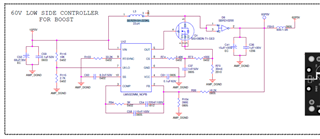Hi TI Team,
I am using LM5022 to boost 15 V to 60V for my application. I will share my schematics below for your reference.
1. If load increased after certain limit, inductor is giving ringing noise after that output current suddenly increased. kindly help us to solve this.

Inductor Spec:
Part. No: SER2915H-223KL.(22uH)
Isat : 6A
DCR : 1.65mohms
Regards
Saravanakumar D



